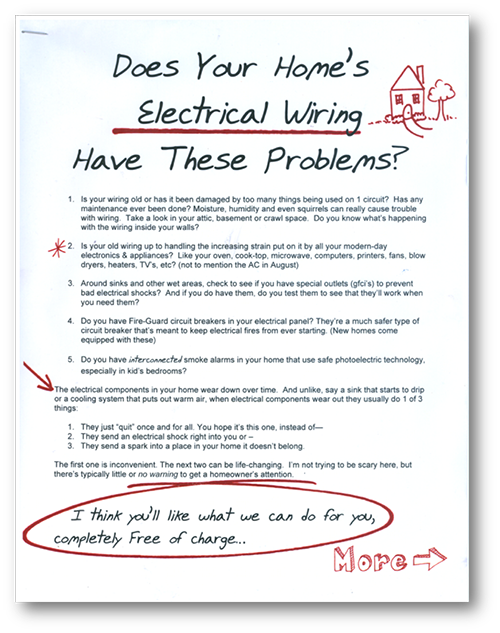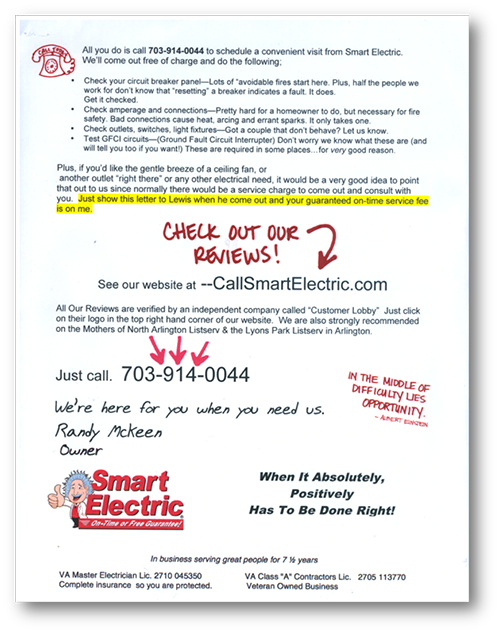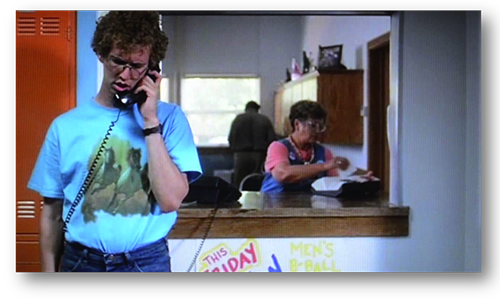When You Say Things That Make Sense To You…
But Not Your Prospects….
Your Sales Letter Is Not Going To Work!
Written by Rich Harshaw.
Beware of the “Curse of Knowledge.”
Simply put, it means that the more you know, the worse off you are. If you’re an expert in a particular field, it’s nearly impossible to imagine what it’s like to NOT know everything you know. So you tend to assume that others share that knowledge—even when they don’t.
The Curse of Knowledge is what causes window companies to brag to prospects about “extrusions” in their marketing and siding companies to quote prices “by the square.” Just because your entire living depends on understanding extrusions and squares, respectively, doesn’t mean your customers have the foggiest clue what you’re talking about.
The owner of an electric company recently submitted a two-page sales letter to me that was doomed by the Curse of Knowledge from the first paragraph to the last. Which meant that readers couldn’t understand the letter, which meant that they had no idea if they needed his services or not. Which meant that they didn’t call… which meant that he got no sales… which meant that he couldn’t buy his kid the GI Joe with the kung-fu grip for Christmas… and… well, you know. It was all downhill from there.
So let’s take a look at the letter. As you do, let me point out that I really like the Napoleon Dynamite-looking doodles and scribbles all over the page. They give the letter a certain kind of charm and appeal; they’re goofy but not stupid. They invite the reader to engage in the letter, but promise that it won’t be too heavy-handed. In short, I like it.
Also, keep in mind that this letter is intended to be mailed to people who JUST MOVED IN. That makes sense, because statistics clearly show that people spend a ton of money on their new homes within the first year of moving in. Just keep this in mind as you read the letter:


But the real problems come when the reader gets to the text; an array of baffling language overwhelms the letter’s purpose. Specifically, the letter asks the reader if they have problems that ordinary home owners wouldn’t have a clue about. To wit:
- Letter Says: Is your wiring old or has it been damaged by too many things being used on 1 circuit? Has any maintenance ever been done? (edited for content) Do you know what’s happening with the wiring inside your walls?
- Probable Reaction: I have no idea how many things are being used on a given circuit, and if I were, wouldn’t the circuit breaker just, you know, break the circuit to let me know? How would I know if any maintenance has been done? I just moved here!
- Letter Says: Is your old wiring up to handling the increasing strain put on it by modern-day electronics and appliances?
- Probable Reaction: How would anyone be able to judge such a thing. Just to keep the Napoleon Dynamite theme going… click here.
- Letter Says: Do you have Fire-Guard breakers in your electrical panel?
- Probable Reaction: Fire-what?
- Letter Says: Do you have interconnected smoke alarms in your home that use safe photoelectric technology, especially in kids’ bedrooms?
- Probable Reaction: ?!?!?
SOLUTION:
Simple: Start the letter off with problems that people can readily identify and confirm that they have in their home. How about this for the initial list:
- Anything Not Working? Do you have any mystery switches that don’t seem to control anything? Are there outlets that simply do not have power? What about broken fans, loud light fixtures (especially fluorescent), broken ballasts, or iffy-looking fixtures?
- Anything Missing? Do you need a ceiling fan installed… or a new or different light fixture? Would you like an electrical outlet somewhere in your home? (Master closets are a prime suspect—so you can charge your devices).
- Water-Shock Safe? Do you have special outlets to prevent electric shocks near sinks, showers, and tubs? If so, have you tested them to see if they work?
- Do Your Smoke Alarms Work? At a minimum you should change out all the batteries. You may want to have them professionally tested; alarms over fifteen years old may need to be replaced.
- Quick Visual Inspection: Does everything LOOK okay? Take a look in the attic, at the breaker box, and at the condition of your outlets. Especially in older homes, you might find things that just don’t look right. If so, don’t chance it.
See how those questions are easy for the average person to understand and answer? Notice how we’re giving them a list of things to think about—and maybe even scare them a little. Since the downside of bad wiring is that PEOPLE’S HOMES CAN BURN DOWN, a little fear is justified.
When you start a letter with a bunch of stuff that people don’t understand, it’s unlikely that they’re going to continue reading much further. But just for grins, let’s explore a few more foundational problems with the letter:
- Lack of easy to read sub-headers: There are three pretty nasty problems that can arise from faulty electrical wiring, but they’re buried at the bottom of the first page in a list that has no header. Look at my revised list of questions/problems above to get an idea how to use short headers.
- The offer on page two isn’t very obvious. The red text gets my attention, but there is no offer in red, even though they teased me with one at the bottom of page one. How about this:
Normally $99. FREE If You Moved In Within The Last 90 Days.
- Then, instead of that hard-to-read-and-mostly-garbled list of bullet points, I’d put a 22-point bullet list with short bullets for each of the 22 things included in the test.
- It’s hard for people to connect the random Albert Einstein quote with the fact that their logo has a little cartoon Einstein in it. The net result is that the quote seems weird and out of place and worthless. I’d skip it.
That should do it—a lot of things to LIKE about this letter… but some fundamental flaws that are holding it back. Make these minor changes and watch the phone start ringing. Like this.

© 2014 – 2016, Rich Harshaw. All rights reserved.








